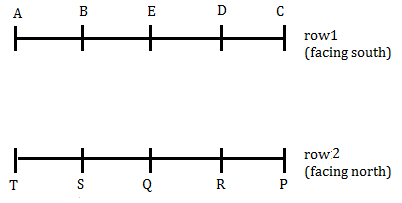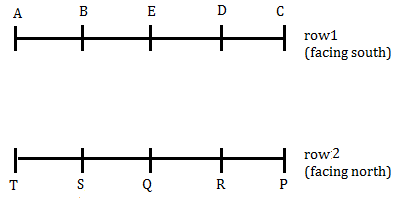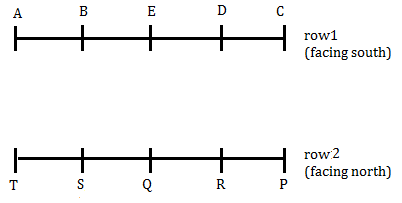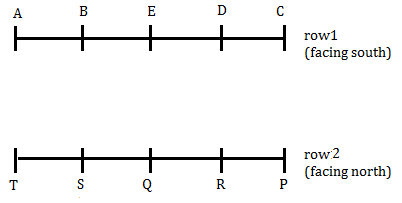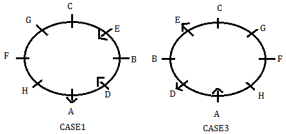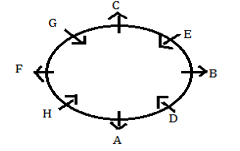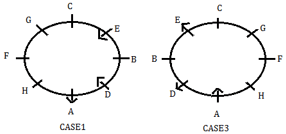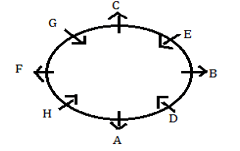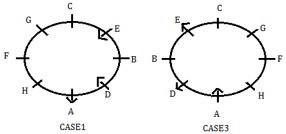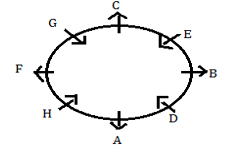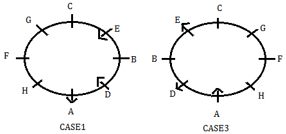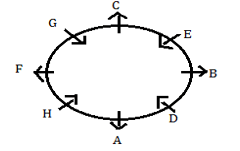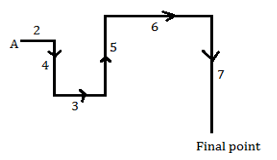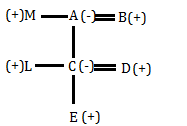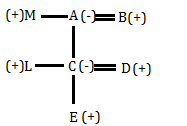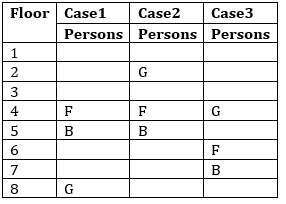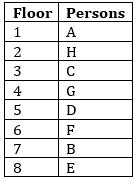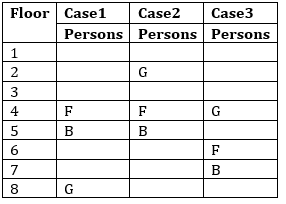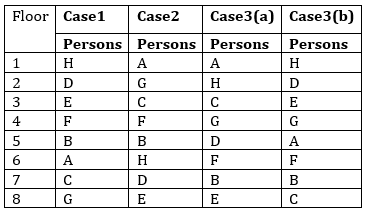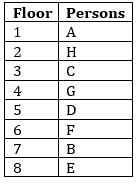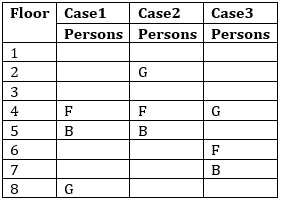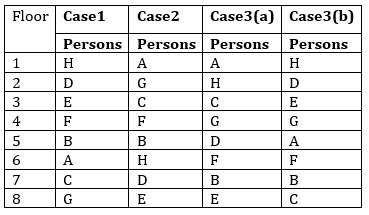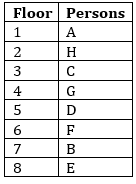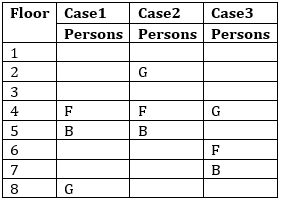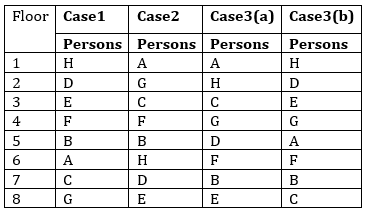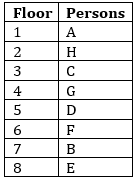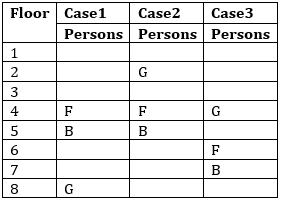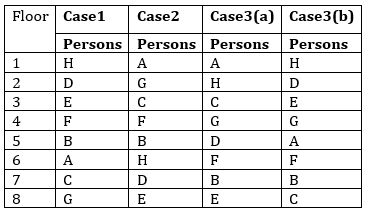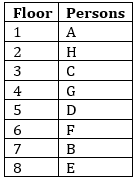NIACL Mock Test - 2 - Insurance MCQ
30 Questions MCQ Test NIACL (New India Insurance) Mock Test Series 2025 - NIACL Mock Test - 2
Study the following information carefully and answer the given questions
Ten persons are sitting in two parallel rows containing five persons in each row. In 1st row A, B, C, D, and E are seated and face south and in 2nd row P, Q, R, S, and T are seated and face north, but not necessarily in the same order. Therefore, in the given seating arrangement, each member seated in a row faces another member of the other row. E does not face R, who does not face A. C is diagonally opposite to T, who sits at one of the ends. Two persons sit between S and P. One person sits between E and C. S doesn’t face C or D. A is not neighbor of E. More than two persons sit to the right of the one who faces B.
Q. Who among the following faces S?
Study the following information carefully and answer the given questions
Ten persons are sitting in two parallel rows containing five persons in each row. In 1st row A, B, C, D and E are seated and face south and in 2nd row P, Q, R, S and T are seated and face north, but not necessarily in the same order. Therefore, in the given seating arrangement, each member seated in a row faces another member of the other row. E does not face R, who does not face A. C is diagonally opposite to T, who sits at one of the ends. Two persons sit between S and P. One person sits between E and C. S doesn’t face C or D. A is not neighbor of E. More than two persons sit to the right of the one who faces B.
Q. How many persons sit between P and T?
Study the following information carefully and answer the given questions
Ten persons are sitting in two parallel rows containing five persons in each row. In 1st row A, B, C, D and E are seated and face south and in 2nd row P, Q, R, S and T are seated and face north, but not necessarily in the same order. Therefore, in the given seating arrangement, each member seated in a row faces another member of the other row. E does not face R, who does not face A. C is diagonally opposite to T, who sits at one of the ends. Two persons sit between S and P. One person sits between E and C. S doesn’t face C or D. A is not neighbor of E. More than two persons sit to the right of the one who faces B.
Q. Who sits 3rd right to E?
Study the following information carefully and answer the given questions
Ten persons are sitting in two parallel rows containing five persons in each row. In 1st row A, B, C, D and E are seated and face south and in 2nd row P, Q, R, S and T are seated and face north, but not necessarily in the same order. Therefore, in the given seating arrangement, each member seated in a row faces another member of the other row. E does not face R, who does not face A. C is diagonally opposite to T, who sits at one of the ends. Two persons sit between S and P. One person sits between E and C. S doesn’t face C or D. A is not neighbor of E. More than two persons sit to the right of the one who faces B.
Q. Who among the following faces the one who sits 2nd left to Q?
Study the following information carefully and answer the given questions
Ten persons are sitting in two parallel rows containing five persons in each row. In 1st row A, B, C, D, and E are seated and face south and in 2nd row P, Q, R, S, and T are seated and face north, but not necessarily in the same order. Therefore, in the given seating arrangement, each member seated in a row faces another member of the other row. E does not face R, who does not face A. C is diagonally opposite to T, who sits at one of the ends. Two persons sit between S and P. One person sits between E and C. S doesn’t face C or D. A is not neighbor of E. More than two persons sit to the right of the one who faces B.
Q. Four of the five are alike in a certain way, who among the following does not belongs to that group?
In each of the questions given below some statements are followed by some conclusions. You have to take the given statements to be true even if they seem to be at variance from commonly known facts. Read all the conclusions and then decide which of the given conclusions logically follows from the given statements disregarding commonly known facts.
Statements:
Some fifty is hundred.
All ten is twenty.
No ten are hundred.
Conclusions:
I. Some fifty is twenty.
II. Some fifty is not ten.
In each of the questions given below some statements are followed by some conclusions. You have to take the given statements to be true even if they seem to be at variance from commonly known facts. Read all the conclusions and then decide which of the given conclusions logically follows from the given statements disregarding commonly known facts.
Statements:
All month are year.
All day is month.
No month is week.
Conclusions:
I. Some year is not week.
II. All day being year is a possibility.
In each of the questions given below some statements are followed by some conclusions. You have to take the given statements to be true even if they seem to be at variance from commonly known facts. Read all the conclusions and then decide which of the given conclusions logically follows from the given statements disregarding commonly known facts.
Statements:
Some can is ran.
Some ran is van.
Some van is man.
Conclusions:
I. No man is ran.
II. Some man is ran.
In each of the questions given below some statements are followed by some conclusions. You have to take the given statements to be true even if they seem to be at variance from commonly known facts. Read all the conclusions and then decide which of the given conclusions logically follows from the given statements disregarding commonly known facts.
Statements:
All rose is lily.
Some rose is cactus.
Some cactus is lotus.
Conclusions:
I. Some lily is cactus.
II. Some lotus being lily is a possibility.
In each of the questions given below some statements are followed by some conclusions. You have to take the given statements to be true even if they seem to be at variance from commonly known facts. Read all the conclusions and then decide which of the given conclusions logically follows from the given statements disregarding commonly known facts.
Statements:
Some Sumit are Harsh.
All Harsh and Sumit are Naveen.
No Naveen is Adarsh.
Conclusions:
I. Some Adarsh can be Sumit.
II. All Harsh is Sumit.
Study the following information carefully and answer the given questions.
Eight persons A, B, C, D, E, F, G and H are sitting around a circular table. Four of them are facing the centre while the rest are facing away from the centre. F sits 2nd right to A. G is one of the neighbors of F. B sits immediate left to E but does not face H. D faces G. C sits 3rd right to D. G and H face same direction as E, but do not face away from the centre.
Q. Who among the following faces E?
Study the following information carefully and answer the given questions.
Eight persons A, B, C, D, E, F, G and H are sitting around a circular table. Four of them are facing the centre while the rest are facing away from the centre. F sits 2nd right to A. G is one of the neighbors of F. B sits immediate left to E but does not face H. D faces G. C sits 3rd right to D. G and H face same direction as E, but do not face away from the centre.
Q. How many persons sit between C and F, from the right of F?
Study the following information carefully and answer the given questions.
Eight persons A, B, C, D, E, F, G and H are sitting around a circular table. Four of them are facing the centre while the rest are facing away from the centre. F sits 2nd right to A. G is one of the neighbors of F. B sits immediate left to E but does not face H. D faces G. C sits 3rd right to D. G and H face same direction as E, but do not face away from the centre.
Q. Who sits 3rd right to E?
Study the following information carefully and answer the given questions.
Eight persons A, B, C, D, E, F, G and H are sitting around a circular table. Four of them are facing the centre while the rest are facing away from the centre. F sits 2nd right to A. G is one of the neighbors of F. B sits immediate left to E but does not face H. D faces G. C sits 3rd right to D. G and H face same direction as E, but do not face away from the centre.
Q. Four of the five are alike in a certain way, who among the following does not belongs to that group?
Study the following information carefully and answer the given questions.
Eight persons A, B, C, D, E, F, G and H are sitting around a circular table. Four of them are facing the centre while the rest are facing away from the centre. F sits 2nd right to A. G is one of the neighbors of F. B sits immediate left to E but does not face H. D faces G. C sits 3rd right to D. G and H face same direction as E, but do not face away from the centre.
Q. Who among the following sits 3rd to the left of the one who is immediate right to G?
Read the following information carefully and answer the given questions.
J W E U T B Q M N Q W P W I S O C B U S A V J R E G I R E G W S D N V
Q. Which letter will be 10th to the left of 16th letter from the left?
Read the following information carefully and answer the given questions.
J W E U T B Q M N Q W P W I S O C B U S A V J R E G I R E G W S D N V
Q. Which letter will be 11th to the left of 26th letter from the left?
Read the following information carefully and answer the given questions.
J W E U T B Q M N Q W P W I S O C B U S A V J R E G I R E G W S D N V
Q. Which letter will be 8th to the right of 26th letter from the right?
Read the following information carefully and answer the given questions.
J W E U T B Q M N Q W P W I S O C B U S A V J R E G I R E G W S D N V
Q. Which letter will be 6th to the left of 11th letter from the right?
Read the following information carefully and answer the given questions.
J W E U T B Q M N Q W P W I S O C B U S A V J R E G I R E G W S D N V
Q. Which letter will be 17th to the left of 19th letter from the left?
Read the following information carefully and answer the given questions
Mamta starts walking from point A towards east and walked 2km before taking a right turn. After the turn she walks 4km. She then takes two consecutive left turns and walks 3km and 5km respectively. Finally, she takes two consecutive right turns and walks 6km and 7km respectively.
Q. In which direction is Mamta’s initial position with respect to her 2nd last turn?
Read the following information carefully and answer the given questions
Mamta starts walking from point A towards east and walked 2km before taking a right turn. After the turn she walks 4km. She then takes two consecutive left turns and walks 3km and 5km respectively. Finally, she takes two consecutive right turns and walks 6km and 7km respectively.
Q. What is the total distance travelled by Mamta?
Study the following information carefully and answer the given questions
In a family of seven members, there are two married couple. Each female has a brother. L and M are unmarried. E is the grandchild of B, who is a male. C is married to D, but is not the father of E. M is older to L and belong to different generation. A is one of the member.
Q. How is E related to L?
Study the following information carefully and answer the given questions
In a family of seven members, there are two married couple. Each female has a brother. L and M are unmarried. E is the grandchild of B, who is a male. C is married to D, but is not the father of E. M is older to L and belong to different generation. A is one of the member.
Q. How many females are there in the family?
Study the following information carefully and answer the given questions
Eight persons are living in an eight storeyed building such that the ground floor is numbered eighth and the floor above it is numbered seventh and so on till the top floor numbered one. F lives just above B. The number of persons living between H and D is same as between D and E. H lives above E. Two persons live between B and G. C lives below A but not just below. More than one person lives between A and G. F does not lives on odd numbered floor.
Q. How many persons live between G and C?
Study the following information carefully and answer the given questions
Eight persons are living in an eight storeyed building such that the ground floor is numbered eighth and the floor above it is numbered seventh and so on till the top floor numbered one. F lives just above B. The number of persons living between H and D is same as between D and E. H lives above E. Two persons live between B and G. C lives below A but not just below. More than one person lives between A and G. F does not lives on oodd-numbered floor.
Q. On which of the following floors does D lives?
Study the following information carefully and answer the given questions
Eight persons are living in an eight storeyed building such that the ground floor is numbered eighth and the floor above it is numbered seventh and so on till the top floor numbered one. F lives just above B. The number of persons living between H and D is same as between D and E. H lives above E. Two persons live between B and G. C lives below A but not just below. More than one person lives between A and G. F does not lives on odd numbered floor.
Q. Which of the following lives just below E?
Study the following information carefully and answer the given questions
Eight persons are living in an eight storeyed building such that the ground floor is numbered eighth and the floor above it is numbered seventh and so on till the top floor numbered one. F lives just above B. The number of persons living between H and D is same as between D and E. H lives above E. Two persons live between B and G. C lives below A but not just below. More than one person lives between A and G. F does not lives on odd numbered floor.
Q. On which of the following floors does B live?
Study the following information carefully and answer the given questions
Eight persons are living in an eight storeyed building such that the ground floor is numbered eighth and the floor above it is numbered seventh and so on till the top floor numbered one. F lives just above B. The number of persons living between H and D is same as between D and E. H lives above E. Two persons live between B and G. C lives below A but not just below. More than one person lives between A and G. F does not lives on odd numbered floor.
Q. Which of the following represents the persons living on top and bottom most floor respectively?
In these questions, relationship between different elements is shown in the statements. These statements are followed by two conclusions:
Statements:
P ≤ Q < R ≥ S < T
Conclusions:
I. R > P
II. P ≥ R




